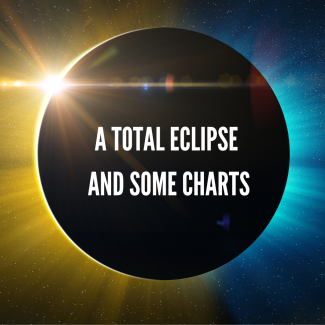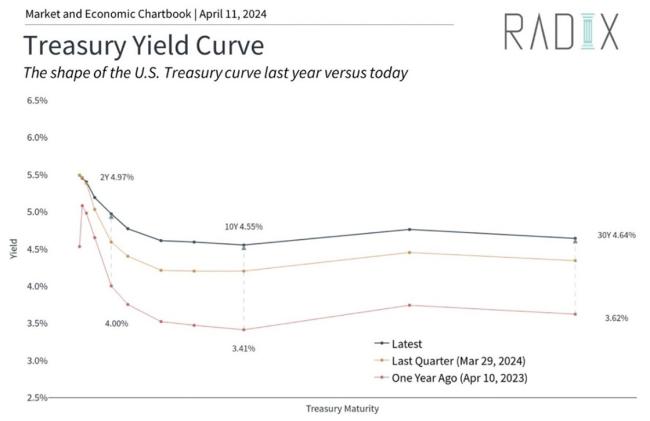
A Total Eclipse and Some Charts
I’ll admit, I got caught up in the hype of the eclipse on Monday. I got my glasses and put it on my calendar to go outside and marvel at the celestial phenomenon which would not happen again until 2044. I was in Oklahoma City that day, relatively close to the path of totality and with a 93% eclipse, I assumed it would be basically the same.
But even with 93% blocked, the dimmed sunlight was barely noticeable. And while we had fun taking pictures outside in our glasses…it was somewhat anti-climactic, and the sun quickly returned to full glory.
…where are you going with this?
Like the sun, markets too have their moments of shadow—periods of volatility, uncertainty, or downturns that can obscure the long-term view of our financial goals. But much like the predictability and transient nature of an eclipse, these market shadows are both temporary and part of a larger, predictable cycle of interest rate ecosystems.
Jess and I spend an inordinate amount of time thinking, talking, writing, and making stupid videos about interest rates, because understanding this ecosystem is the single most important macro consideration to investment asset allocation decisions.
Specifically, it’s important to understand:
- What affects Fed rate policy?
- Are interest rates likely to move higher or lower in the future?
- How should the answer to #1 and #2 affect my financial decisions?
Lucky for you, we have you covered on all three points.
The Federal Open Market Committee (“the Fed” or “FOMC”) led by Chairman Jay Powell have the power to stimulate or constrain economic activity within the US, as needed. They have several tools in their toolbox, but their primary mechanism is via control of the Fed Funds rate, which serves as a baseline rate for all personal and commercial loans. For those in Cayman – the Fed Funds Rate + 3% is generally what is considered to be the “Prime Rate.”
Raising the Fed Funds Rate or “tightening” (as was aggressively done in Jan 2022 – July 2023) serves to reign in economic activity and fight high inflation. Inflation (at least within t
oday’s context) occurs when the economic infrastructure (backlogged supply chains, lack of skilled labor, manufacturing capacity) can’t keep up with the demand for growth, as we saw after the reopening of the economy after Covid-19.
Cutting the Fed Funds Rate or “easing” serves to stimulate economic activity, spur hiring, and add money to the system. This is usually done in response to or avoidance of an economic crisis, such as a recession (like 2008) or a significant market destabilizing event such as Covid-19 or 9/11.
The two most important data points that the Fed looks at when making this decision (they meet 8x per year) are 1) inflation (CPI & core PCE) and 2) employment (non-farm payrolls). Even if you pay no attention to any other economic reports, the likely route that the Fed will take can generally be inferred from these two points alone.
ARE INTEREST RATES LIKELY TO MOVE HIGHER OR LOWER IN THE FUTURE?
Simple Answer: lower (probably)
The Fed governors release to the public a quarterly Summary of Economic Projections (“dot plot”) which reveals each of their individual expectations for how they intend to vote in the near term.
As of the most recent dot plot released in March, the consensus is that the Fed is likely done with the hiking cycle and now expects to begin gradually lowering the target rate from where they have sat at a 23-year-high since July of last year. The median consensus (in March) was that we would likely see at least two 0.25% cuts this year.
The “problem” with the Fed publishing their hopes and dreams for the future is that the markets (both credit and equity) tend to take it as a gospel promise that we WILL have cuts this year, when in reality, future Fed action is completely “data-dependent” and subject to constant revision.
The March non-farm payrolls number continues to be strong, meaning the Fed cannot justify a rate cut on the basis of weakening unemployment. The March CPI inflation reading was also pretty toasty, with YoY core inflation climbing to 3.8%, a move in the wrong direction away from the Fed’s 2% long-term target.
The Fed’s next meeting is May 1st and given these March readings, I’d be willing to bet the farm that we will not see a rate cut at that meeting.
While there is still plenty of year left for the Fed to make good on their ‘cuts in 2024’ promises, the longer the delay, the more impatient markets are likely to become.
HOW SHOULD THE ANSWERS TO #1 AND #2 AFFECT MY FINANCIAL DECISIONS?
Let’s break it down by asset class…
Stocks
The S&P 500 has achieved 20 new all-time highs so far this year, despite the brief market pullback during the first two weeks of the year. While this is positive for investors, it is easy to worry that continued market growth may not be sustainable if inflation proves to be persistent. Do new all-time highs mean that the market is due for a pullback?
Not usually. During a bull market cycle, major stock market indices will naturally spend a significant amount of time near record levels, as shown in the below chart. For instance, 2021 experienced 70 days with the market closing at new all-time highs, adding to the hundreds that were achieved since 2013.
Taking a long-term perspective allows investors to benefit from these market trends without constantly worrying about when a pullback might occur. So despite the risks, for long-term investors, we continue to believe that the best strategy is to “Just Keep Buying.” And for extra credit, check out Nick Maggiulli’s book by the same name.
Cash
Below is the US Treasury yield curve which shows the interest rate that the US government, widely considered to be the safest asset in the world, is paying over various time frames. You’ll notice that the curve is “inverted” meaning that shorter-term rates (such as cash) are paying higher than longer-term bonds. This is unusual, but generally serves as a harbinger that the Fed Funds rate is soon to drop.
The trap that I’m seeing A LOT of folks falling into is being lured by high short-term cash yield for long-term money. The thinking is “why would I invest in longer-dated bonds or put my money at risk when cash is yielding a higher rate?”
Remember that in #2 we decided that interest rates are forecasted to fall in the near future. This means your cash yield will immediately go down, as well as the opportunity lost to lock-in a longer-term, low-risk fixed income yield of over 5% for many years to come (more on this below).
For short-term cash you will need within 18 months, a high yield saving account or CDs are great. But for longer-term savings and investments – ignore the cash yields, IT’S A TRAP, as they’re temporary and fleeting.
Bonds
Looking back at the yield curve chart above, you’ll notice that in the short period from March 29th to today (April 11th), the yield curve has noticeably shifted up in response to the unemployment and inflation readings released over the last week. The sell-off is a clear signal that the credit markets no longer believe that rates will be dropping in the next month.
This gives us a fresh window of opportunity to purchase intermediate term bonds at levels (5.5%+ for investment grade credit) not seen since last November. An opportunity which we believed was gone forever.
In addition to locking in rates at near 15-year highs, the opportunity set gets even better if you believe that rates will be lower in the future, because bond prices move inversely with rates. Consider the table below from JP Morgan, which estimates the total return impact of a 1% decrease in rates. Longer dated bonds (we do not buy anything over 10 years) have higher modified duration, making them more sensitive to changes in interest rates than short term bonds. So as interest rates/yields fall we would expect prices to rise, increasing total return, which is especially beneficial to taxable investors in pooled bond funds.
Real Estate
Real Estate, like all assets and industries which rely heavily on leverage, is having a hard time. In addition to the high maintenance costs and headaches that come along with Real Estate ownership and investment, average 30-year mortgage rates in the US are near 7% and in the Cayman Islands 8.5%. What we’d suggest varies with your individual situation.
- It’s almost always a good financial decision to own your home. It allows you to build equity as an investment rather than paying rent to someone else. However, real estate investing outside of your primary home (unless you can pay cash) is generally not going to be the most profitable move in today’s environment.
- If you’re one of the 79% of US homeowners with fixed rate mortgages below 5% and no intention to move - we suggest making the minimum payment and investing excess cash flow in a diversified portfolio of liquid stocks and bonds. You’re the lucky ones, do not be in a hurry to pay that off.
- If you’re looking to buy a home – we suggest considering a variable rate mortgage. If you believe that rates will fall in the future, you will benefit from the auto-recalculation of your interest rate lower in response.
- If you’re already in a variable rate mortgage or have purchased a new home in the past year and your interest rate is higher than 6.5% - it may make sense to put excess cash towards paying down the principal of your house, and when rates come down, look to refinance. A warning though! You do not want to accidentally find yourself “house rich” and “cash poor,” make sure you’re appropriately balancing your liquid retirement savings.
FINAL WORD
On March 27th, the world lost the Nobel Prize winning father of behavioral economics, Daniel Kahneman. His seminal work on Prospect Theory alongside his friend and collaborator Amos Tversky challenged everything we know about market dynamics and exposed the fallacy of our own heuristic biases.
I’d encourage anyone to read Michael Lewis’ book “The Undoing Project” which illuminates Kahneman and Tversky’s work. You can also give Kahneman’s own masterpiece “Thinking Fast and Slow” a go, but I’ll warn you that it’s overly technical to be enjoyed by most casual readers.
As always, we encourage you to reach out with questions, comments, or fan mail.
Amy & Jess


